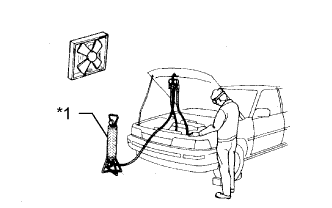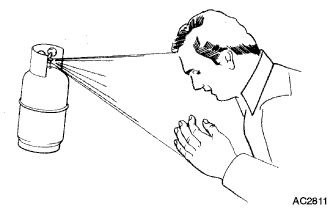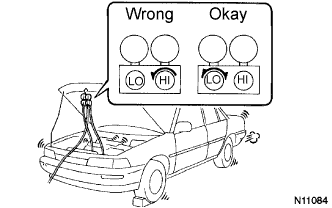AIR CONDITIONING SYSTEM > PRECAUTION |
| 1.PRECAUTION FOR DISCONNECTING CABLE FROM NEGATIVE BATTERY TERMINAL |
| System Name | See Procedure |
| Intelligent Parking Assist System |
Click here
|
| 2.GENERAL PRECAUTION |
While using the battery during inspection, do not bring the positive (+) and negative (-) tester probes too close to each other as a short circuit may occur.
| 3.PRECAUTIONS WHEN USING INTELLIGENT TESTER |
When using the intelligent tester with the power switch off to troubleshoot:
Connect the intelligent tester to the vehicle, and turn a courtesy light switch on and off at 1.5-second intervals until communication between the intelligent tester and vehicle begins.
After all DTCs are cleared, check if the trouble occurs again 6 seconds after the power switch is turned on (IG).
| 4.DO NOT HANDLE REFRIGERANT IN ENCLOSED AREA OR NEAR OPEN FLAME |
 |
| *1 | Charging Cylinder |
| 5.ALWAYS WEAR EYE PROTECTION |
| 6.BE CAREFUL NOT TO GET LIQUID REFRIGERANT IN YOUR EYES OR ON YOUR SKIN |
 |
Wash the area with lots of cold water.
Apply clean petroleum jelly to the skin.
Go immediately to a hospital or see a physician for professional treatment.
| 7.NEVER HEAT CONTAINER OR EXPOSE THE CONTAINER TO AN OPEN FLAME |
| 8.BE CAREFUL NOT TO DROP CONTAINER OR APPLY PHYSICAL SHOCKS TO IT |
| 9.DO NOT OPERATE COMPRESSOR WITHOUT ENOUGH REFRIGERANT IN AIR CONDITIONING SYSTEM |
 |
| 10.DO NOT OPEN HIGH PRESSURE MANIFOLD VALVE WHILE COMPRESSOR IS OPERATING |
Open and close only the low pressure valve.
If the high pressure valve is opened, refrigerant flows in the reverse direction causing the charging cylinder to rupture.
| 11.BE CAREFUL NOT TO OVERCHARGE SYSTEM WITH REFRIGERANT |
| 12.DO NOT OPERATE COMPRESSOR WITHOUT REFRIGERANT |
| 13.PRECAUTIONS TO BE OBSERVED WHILE SERVICING |
| 14.SUPPLEMENTAL RESTRAINT SYSTEM (SRS) |
This vehicle is equipped with an Supplemental Restraint System (SRS) such as the driver, front passenger, side and curtain shield airbags. Failure to carry out service operations in the correct sequence could cause the SRS to unexpectedly deploy during servicing, possibly leading to a serious accident. Before servicing (including removal or installation of parts, inspection or replacement), be sure to read the precautionary notices (Click here).
| 15.PRECAUTIONS WHEN WORKING (w/ Remote Air Conditioning System and Solar Ventilation System) |
Vehicles with the remote air conditioning system have the following risks that it is necessary to be aware of when performing repairs. Therefore, make sure to take care of the key (electrical transmitter) carefully so that the remote air conditioning system is not operated unexpectedly.
| The electrical fan and other items in the engine compartment may operate resulting in various hazards. |
| The wipers may operate if the wiper switch is in the on position when the remote air conditioning system is activated. If this occurs, there is the potential for damage to the glass, wipers or injury. |
| When the light control switch is in the tail, head or AUTO position, the headlights may turn on. |
| Short circuits may occur if electrical inspections are being performed when the remote air conditioning system is turned on, because the IG circuit is powered at this time. |
When performing repairs on vehicles with the solar ventilation system, turn the solar ventilation switch off.